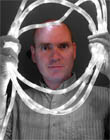|
|
This topic comprises 3 pages: 1 2 3
|
|
Author
|
Topic: Lawrence of Arabia on DVD
|
Jerry Chase
Phenomenal Film Handler

Posts: 1068
From: Margate, FL, USA
Registered: Nov 2000
|
 posted 08-13-2001 09:08 AM
posted 08-13-2001 09:08 AM




I was watching Lawrence again last night and was again in awe of how crystal clear the picture was, so I decided to check something out that had bothered me about the film. When Lawrence is crossing the desert, supposedly with fifty of Fiasel's men, the number of men seemed to be less than that and change from scene to scene. Pausing the DVD and counting, I could count 36 camels in one shot of the group resting and forty something in another. The DVD is sharp enough that in the resting shot it is possible to determine which of the dots on the plain are camels and which are probably blankets or men because of the necks showing on the camels.I point this out for those who dismiss the threat of good video. One problem I do have, though, is when I don't diffuse the sharpness a little the steps artifact. As Evans points out, video needs to get away from using lines and more to a random or semi-random grain structure to avoid such problems. Is anyone else bothered that the railroad line in the first segment of the picture appears to be a 2 or 3 foot gauge and the later trains are more standard gauge? My other picky points on this film are 1. Sharif removing his headpiece and throwing it on the ground in disgust. That would be an offense to Allah, not to Lawrence. 2. The processing marks that show up in the sky as light vertical moving bands. I remember being surprised that this wasn't fixed in the otherwise amazing restoration.
| IP: Logged
|
|
Evans A Criswell
Phenomenal Film Handler

Posts: 1579
From: Huntsville, AL, USA
Registered: Mar 2000
|
 posted 08-13-2001 09:50 AM
posted 08-13-2001 09:50 AM





quote:
I point this out for those who dismiss the threat of good video. One problem I do have, though, is when I don't diffuse the sharpness a little the steps artifact. As Evans points out, video needs to get away from using lines and more to a random or semi-random grain structure to avoid such problems.
It is best with DVD to find the correct sharpness setting so that no false high frequency information is being added (or more accurately, no boost is given to the high frequencies). This varies from set to set. On my set, the correct setting is to have the sharpness all the way down, believe it or not. On newer Sonys, the correct setting is approximately one third or one fourth of the way up. If your set has a way to turn off SVM (Scanning Velocity Modulation), turn it off, because it causes an effect similar to having the sharpness run up too high. With DVD, using S-Video or Component video cables to get the highest quality picture possible, there is no reason to run the sharpness up higher than the "flat response" setting since doing so will often cause the artifacts from the MPEG2 compression to become noticeable. With NTSC video, the "steps" artifacts are on any video source, analog or digital, due to the discrete nature of the signal in the vertical direction (480 visible scan lines). Analog video is a strange animal. It's continuous horizontally and discrete vertically. It wouldn't matter if you had a video format and a receiver that could both display in infinite number of "pixels" of information on each scan line. The limitation of 480 scan lines is a problem with NTSC. Anyway, until some sort of HDTV version of DVD comes out, DVD's as they are now are the best home video movies you can get. I just wish they'd made the anamorphic encoding always use all 480 scan lines, regardless of the aspect ratio, and required the players/sets to cope with figuring out the amount of unsqueeze/squeeze to apply. Doing it this way would have allowed scope movies to be encoded with 720 by 480 resolution rather than 720 by 357. It seems that at home, the flat ratio is always the one that is going to look better (with more image detail). It may take several years, but I do think home video will eventually hurt movie theatres more than they do now. As larger, brighter, less expensive screens become available, more people will buy them and stay home more. Sound systems are already there, just waiting for the screens and picture quality to catch up. ------------------
Evans A Criswell
Huntsville-Decatur Movie Theatre Information Site
| IP: Logged
|
|
Mitchell Cope
Master Film Handler

Posts: 256
From: Overland Park, KS, United States
Registered: Jun 99
|
 posted 08-13-2001 01:01 PM
posted 08-13-2001 01:01 PM




Evans said, quote:
It may take several years, but I do think home video will eventually hurt movie theatres more than they do now. As larger, brighter, less expensive screens become available, more people will buy them and stay home more.
As far as I know, I don't think "Apocalypse Now Redux" is going to play in a theater in my area (Kansas City). Being down about this I thought, that's the plan. The short theater run is just the advertisement for the upcoming DVD release. The studio would probably lose money to have it shown in more theaters across the country. Now I know everybody is thinking, "Well, duh". The time is here that video is taking the revenue generating handoff. "The horror. The horror."
| IP: Logged
|
|
John Pytlak
Film God

Posts: 9987
From: Rochester, NY 14650-1922
Registered: Jan 2000
|
 posted 08-13-2001 02:14 PM
posted 08-13-2001 02:14 PM





Mitchell Cope said: "As far as I know, I don't think "Apocalypse Now Redux" is going to play in a theater in my area (Kansas City). Being down about this I thought, that's the plan. The short theater run is just the advertisement for the upcoming DVD release. The studio would probably lose money to have it shown in more theaters across the country."Sad, but probably true.  By all accounts, the 35mm dye transfer prints really look great on a big screen. But I was originally wowed by the 70mm presentation of "Apocalypse Now" at the Century City Plitt theatre in LA in 1979. Think what a new 70mm Vision Premier print of "Apocalypse Now Redux" would look like on a huge, well-lit screen.  Nice and convenient as it is, a DVD on a home theatre screen won't even come close to the experience. ------------------
John P. Pytlak, Senior Technical Specialist
Worldwide Technical Services, Entertainment Imaging
Eastman Kodak Company
Research Labs, Building 69, Room 7419
Rochester, New York, 14650-1922 USA
Tel: 716-477-5325 Cell: 716-781-4036 Fax: 716-722-7243
E-Mail: john.pytlak@kodak.com
Web site: http://www.kodak.com/go/motion
| IP: Logged
|
|
|
|
|
|
|
|
|
|
Mark Gulbrandsen
Resident Trollmaster

Posts: 16657
From: Music City
Registered: Jun 99
|
 posted 08-19-2001 07:08 PM
posted 08-19-2001 07:08 PM




Bobby,
1080p is the ultimate destination for hdtv standards, however it will take a long time to get there. The technology is still under development for that system. They can barely make color cameras that can do 1080i right now! To do 1080p will ultimately involve studio and computer upgrades. The present HDTV xmitters will be able to handle it with only small mods. 720p is one of the standrds and ABC is using that system. It actually does not look any better, nor much worse than 1080i does and offers about the same end result. Geez, when you get to 1080 lines, being in interlace scan does not really matter much as the lines are basically invisible, unless of course with those eyes you are watching a foot from the screen. Some might think so.Jerry, regarding the marks in the sky in Lawrence go they came oh so close to completely loosing the camera neg for that film, due mostly to studio assholes engauging in studio politics. Something like two more weeks and the film would no longer exist! As it was the stuff was comming apart while they were making the seps or printing interpositive or whatever they had to do with the neg to bring it back. It is quite amazing that it survived at all and that it looks as good as it does. It is a great tribute to Bob Harris's abilities and I'm sure that restoring that film was the high point in his life's work. I suppose it could have been digitally redone but it was not that big of deal. There were also other minor visible problems as well.
Mark @ GTS
| IP: Logged
|
|
|
|
Tao Yue
Expert Film Handler

Posts: 209
From: Princeton, NJ
Registered: Apr 2001
|
 posted 08-20-2001 09:10 AM
posted 08-20-2001 09:10 AM





Perhaps it was a good thing Lawrence was not digitally restored. Scanning technology wasn't as good in 1989 as it is today. Since the negatives were about to die, a digital restoration would have left us with limited-resolution prints of Lawrence forever.Not to imply that RAH, Katz, and company are digital-phobic. They've used digital technology to pick up where chemical/optical restoration left off. Two examples I can think of right away are the famous Grace Kelly/Jimmy Stewart kiss scene in Rear Window and the substantial chunks of My Fair Lady that had deteriorated too much to be saved chemically. However, IMHO, digital restoration should be left as a last resort. I saw the restoration of A Hard Day's Night and was very annoyed by the pixellation. The contrast also left something to be desired. That negative is pretty much gone, so unfortunately the digital version is the one we're stuck with. ------------------
Tao Yue
MIT '04: Course VI-2, Electrical Engineering and Computer Science
Projectionist, MIT Lecture Series Committee
| IP: Logged
|
|
|
|
Tao Yue
Expert Film Handler

Posts: 209
From: Princeton, NJ
Registered: Apr 2001
|
 posted 08-21-2001 09:10 AM
posted 08-21-2001 09:10 AM





The ON for A Hard Day's Night still exists, but it's in pretty bad shape due to improper storage. Also, the first and last reels of the ON are gone because it was loaned out to make clips, and only part of the film was returned. Those reels had to be restored from other available elements. The remaining reels of the ON had hundreds of prints made from them, as with many old films.I suppose it'll be possible in a hundred years to go back and restore it again. So I should have heeded the maxim, "never say never." We'll be stuck with the digital version for a long time, but perhaps not forever if things are good. But for color films restored digitally, we may indeed be stuck with the digital restoration forever. ------------------
Tao Yue
MIT '04: Course VI-2, Electrical Engineering and Computer Science
Projectionist, MIT Lecture Series Committee
| IP: Logged
|
|
Greg Anderson
Jedi Master Film Handler

Posts: 766
From: Ogden Valley, Utah
Registered: Nov 1999
|
 posted 08-21-2001 10:18 PM
posted 08-21-2001 10:18 PM





I have a wonderful book called Lawrence of Arabia The 30th Anniversary Pictorial History by L. Robert Morris and Lawrence Raskin with a foreward by Martin Scorsese. It's from Anchor Books Doubleday, copyright 1992. It gives a brief history of the real T.E. Lawrence and then the making of the movie... including the restoration. I consider this book a must for any die-hard fans of the film.The end of the chapter about the reconstruction and restoration mentions a screening of the finished "work print" in Los Angeles on May 6, 1988. David Lean attended along with Steven Spielberg and some studio officials. According to the book...
---------------------------
After the screening, Harris set about making final changes and ordering new material to replace dupes or torn negative. He then put in a lab order that a 65mm 'preservation interpositive' be printed off the reassembled original negative. This 'interpositive' -- a low-contrast, fine-grain, positive color print -- is used to create a small number of duplicate negatives. It is these which are used to produce the positive 'prints' which are distributed to cinemas. This strategy prevents wear and tear on the original negative. "As they began to produce the interpositive," Harris recalled with horror, "all of the splices started opening, the perforations began failing, and the negative surface started cracking up: it was starting to fall apart. We were down to the final weeks of life of the negative: it was starting to fall apart. The negative started self-destructing. "There were very few rolls of negative that successfully produced an interpositive the first time through. "One of the reasons that the original negative was in such bad shape, was that in the 60s, 70s, and even the early 80s the duping stocks were so bad that they had used the original negative to make theatrical prints. The negative had been run through a printer over 220 times." Harris was forced to decide -- in each case -- whether to go to the separations, an alternate shot, or a trim piece, to replace the damaged material. What should have taken another week, took four more agonizing months. Finally, in September 1988, the restored 'Director's Cut' of Lawrence of Arabia effectively existed. Sir David Lean's lost masterpiece was ready to return to the cinema.
(copied from page 208) --------------------- Earlier in the chapter there are details about Columbia's idiotic, legal wrangling which almost prevented this movie from ever being restored. Robert Harris is to be applauded... loudly. If I were Steven Spielberg I would take out my personal checkbook and purchase all of Columbia's control of this movie. Then I'd give it to someone who truly cares about it and could preserve this movie for generations to come.
| IP: Logged
|
|
|
|
|
|
All times are Central (GMT -6:00)
|
This topic comprises 3 pages: 1 2 3
|
Powered by Infopop Corporation
UBB.classicTM
6.3.1.2
The Film-Tech Forums are designed for various members related to the cinema industry to express their opinions, viewpoints and testimonials on various products, services and events based upon speculation, personal knowledge and factual information through use, therefore all views represented here allow no liability upon the publishers of this web site and the owners of said views assume no liability for any ill will resulting from these postings. The posts made here are for educational as well as entertainment purposes and as such anyone viewing this portion of the website must accept these views as statements of the author of that opinion
and agrees to release the authors from any and all liability.
|

 Home
Home
 Products
Products
 Store
Store
 Forum
Forum
 Warehouse
Warehouse
 Contact Us
Contact Us




 Printer-friendly view of this topic
Printer-friendly view of this topic




















